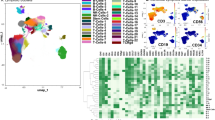Abstract
Dose-escalation during induction and consolidation therapy of de novo AML, including myeloablative chemotherapy supported with autologous peripheral blood stem cell transplantation, continously improve outcome. Therefore, quality control of transplants is getting increasing interest. We studied leukapheresis products (LPs), consecutively collected during postremission treatment of 20 patients (pts) with de novo AML for minimal residual disease (MRD) by 5-parametric flow cytometry and for myelodysplasia (MDS)-associated alterations, within the non-leukemic hematopoietic progenitor cells (HPCs), by paired lineage-selected colony assays for colony-forming units-megakaryocytes (CFU-mega) and burst-granulocytes-monocytes colony-forming units (CFU) to evaluate the predictive value of these transplant-associated parameters on outcome.
We defined the leukemic immunophenotype at diagnosis and studied the impact of MRD detection in LPs collected after double induction with TAD (thioguanine, daunorubicin, cytarabine) and HAM (mitoxantrone, high-dose cytarabine, n=18 pts) and TAD consolidation treatment (n=20 pts) on relapse-free survival of 19 pts with AML entering morphologically complete remission. The level of MRD in the transplants correlated with the relapse-free survival (RFS) using a cut-off level of 0.1% MRD (p=O.OO3). Five of 14 pts (35%) with < 0.1% MRD (median 0.02%, range 0.0 to 0.06%) relapsed within 12 months and all 5 pts with >0.1% MRD (median 0.42%, range 0.15 to 0.63 %) within 18 months. By using the same cut-off level a weak correlation could also be demonstrated between MRD in the pregraft bone marrow and RFS (p=O.O4). Quantitatively abnormal megakaryocytic colony growth in the backup LPs collected after dopple-induction and in the transplant LPs was characterized by the ratio CFU-mega/CFU. In the group of relapsing patients the ratio CFU-mega/CFU was significantly lower than in the group of pts with CCR (p= 0.004), both in the back-ups and in the transplants. All patients with CFUmega/CFU ratios <0.12 relapsed with AML and five of seven pts had a preceding MDS. Using the optimized cut-off level for the ratio CFU mega/CFU (< 0.12), seven of ten relapsing patients (70%) could be identified to be at risk of relapse, whereas MRD in the transplants identified only 50% of the relapses and MRD in the pregraft bone marrow 25%. In conclusion, the study could identify two pretransplant risk-factors predicting relapse in patients with AML receiving aPBSCT in first CR: MRD in transplants as well as MDS-like alterations within the non-leukemic HPCs of the transplants. These results may have multifold implications on the design of risk-adapted chemotherapy as well as on purging techniques and may contribute to a better understanding of leukemogenesis.
Access this chapter
Tax calculation will be finalised at checkout
Purchases are for personal use only
Preview
Unable to display preview. Download preview PDF.
Similar content being viewed by others
References
Reichle A (1998). Transplant characteristics: Minimal residual disease and impaired megakaryocytic colony growth as sensitive parameters for predicting relapse in acute myeloid leukemia. Leukemia 13; 1227–1234
Bennett JM, Catovsky D, Daniel MT, Flandrin G, Galton DA, Gralnick HR, Sultan C (1985). Criteria for the diagnosis of acute leukemia of megakaryocyte lineage (M7). A report of the French-American-British Cooperative Group Ann Intern Med 103:460–462.
Büchner T, Hiddemann W, Wörmann B, Lüffler H, Maschmeyer G, Hossfeld D, Ludwig WD, Nowrousian M, Aul C, Schaefer UW, et al (1992). Longterm effects of prolonged maintenance and of very early intensification chemotherapy in AML: data from AMLCG. Leukemia; 6 Suppl 2: 68–71.
Tutschka PJ, Copelan EA, Klein JP (1997). Bone marrow transplantation for leukemia following a new busulfan and cyclophosphamide regimen. Blood; 70:1382–1388.
Berthier R, Valiron O, Schweitzer A, Marguerie G (1993). Serum-free medium allows the optimal growth of human megakaryocyte progenitors compared with human plasma supplemented culturesrole of TGF beta. Stem Cells Dayt; 11:120–129.
Zauli G, Vitale L, Brunelli MA, Bagnara GP (1992). Prevalence of the primitive megakaryocyte progenitors (BFU-meg) in adult human peripheral blood. Exp Hematol; 20: 850–854.
Goasguen JE; Bennett JM (1992). Classification and morphologic features of the myelodysplastic syndromes. Semin Oncol; 19: 4–13.
Yates J, Glidewell O, Wiernik P, Cooper MR, Steinberg D, Dosik H, Levy R, Hoagland C, Henry P, Gottlieb A, Cornell C, Berenberg J, Hutchison JL, Raich P, Nissen N, Ellison RR, Frelick R, James GW, Falkson G, Silver RT, Haurani F, Green M, Henderson E, Leone L, Holland JF (1982). Cytosine arabinoside with daunorubicin or adriamycin for therapy of acute myelocytic leukemia: a CALGB study. Blood; 60: 454–462.
Rothe G, Schmitz G (1996). Consensus protocol for the flow cytometric immunophenotyping of hematopoietic malignancies. Working Group on Flow Cytometry and Image Analysis. Leukemia; 10: 877–895.
Author information
Authors and Affiliations
Editor information
Editors and Affiliations
Rights and permissions
Copyright information
© 2001 Springer-Verlag Berlin Heidelberg
About this paper
Cite this paper
Reichle, A., Rothe, G., Krause, S., Zaiss, M., Ullrich, H., Andreesen, R. (2001). Transplant Characteristics: Minimal Residual Disease and Impaired Megakaryocytic Colony Growth as Sensitive Parameters for Predicting Relapse in Acute Myeloid Leukemia. In: Büchner, T., Hiddemann, W., Wörmann, B., Schellong, G., Ritter, J., Creutzig, U. (eds) Acute Leukemias VIII. Haematology and Blood Transfusion / Hämatologie und Bluttransfusion, vol 40. Springer, Berlin, Heidelberg. https://doi.org/10.1007/978-3-642-18156-6_114
Download citation
DOI: https://doi.org/10.1007/978-3-642-18156-6_114
Publisher Name: Springer, Berlin, Heidelberg
Print ISBN: 978-3-642-62109-3
Online ISBN: 978-3-642-18156-6
eBook Packages: Springer Book Archive




